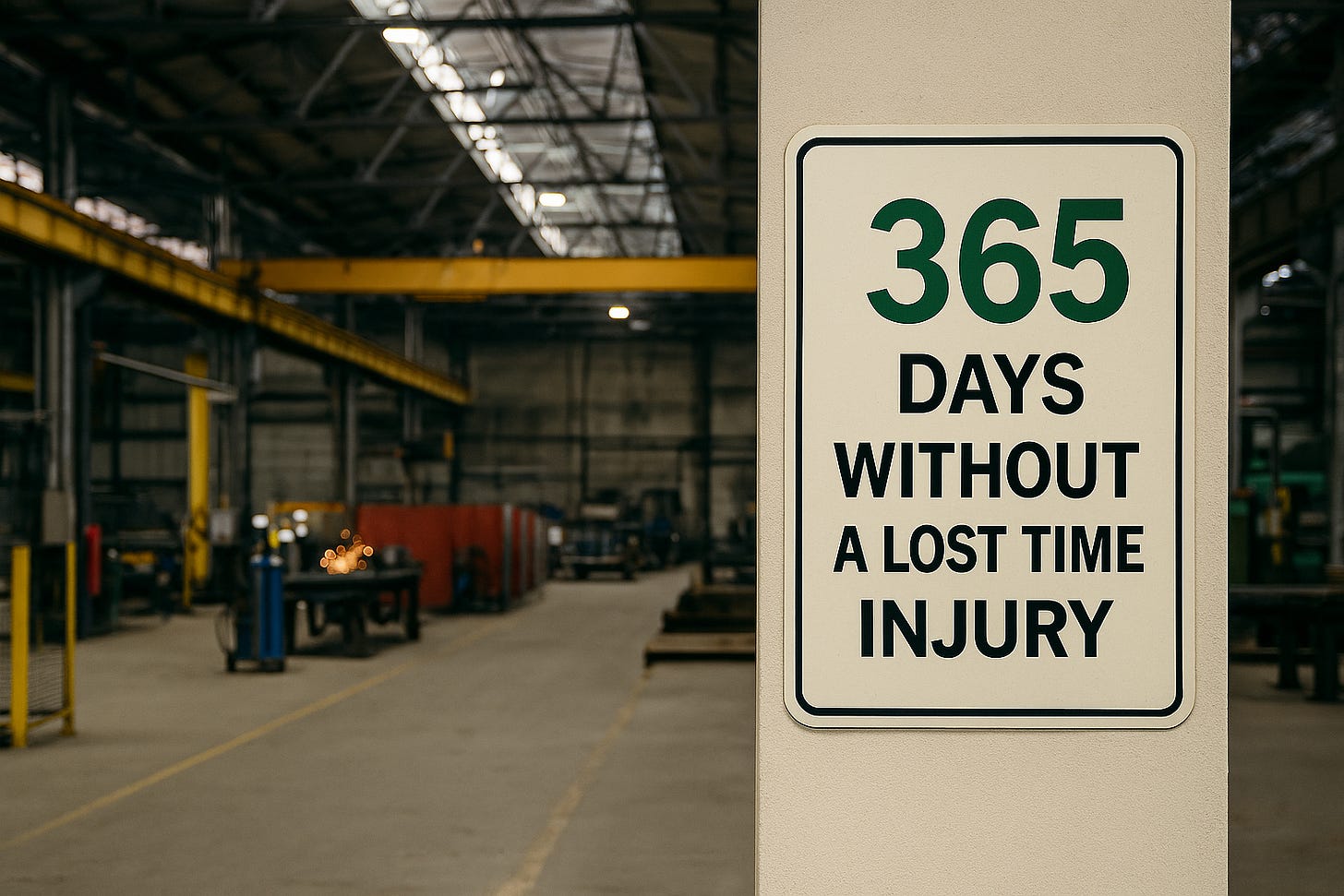Is Chasing Zero Incidents Keeping Us Safer — or Quieter?
The unintended consequences of relentlessly pursuing zero incidents ...
Hello and welcome to this week’s edition of Small Business Safety Pro.
In this week’s message, we’re going to dive into a controversial topic – chasing the goal of zero incidents. Is it achievable, are all accidents preventable, and is this even something we should aspire to when we set goals for our Health and Safety program?
Key points at a glance:
· Zero incidents can seem like a commendable goal, but can lead to unintended consequences that suppress reporting and can make your safety program weaker as a result.
· Furthermore, not all accidents are preventable in the real world due to human factors and the difficulty in predicting and controlling all possible risks.
· A better approach is to focus on the process rather than the outcome and specifically on leading indicators that make workplaces safer and remove the pressure to hit an unrealistic goal.
Many companies have the goal of zero incidents written into their safety policy. It sounds reasonable, right? No company or executive wants to see an employee get hurt.
But there are several reasons why chasing a goal of zero incidents is dangerous and we’ll explore those shortly.
Why Zero Is a Tempting Target
First of all, why do many companies look at zero incidents as a desirable target?
It’s clear, simple, and makes a strong statement.
It’s easily measured and can be tied to bonuses, performance reviews, or even a company’s branding.
Aiming for zero feels like progress and commitment.
Aiming for zero sounds like a laudable goal, and when kept in the proper perspective it is.
However, the blind pursuit of zero incidents can have significant unintended consequences. These consequences may not be initially obvious, but can creep into your company’s safety culture and turn it into something you never expected.
The Unintended Consequences of a Zero-Driven Culture
A zero-driven culture looks good on paper, but if taken too far can lead to some decidedly unhealthy practices:
Workers feel pressure not to report incidents or near misses. This is a key point. If there is pressure (real or imagined), to suppress reporting of incidents, you’re going to miss out on key information that can help make your workplace safe. While each incident is regrettable, thorough investigation of the incident and effective corrective actions taken as a result give you an opportunity to prevent a similar incident in the future and make your workplace safer.
Supervisors may downplay issues to keep numbers clean. Particularly if safety numbers are tied to bonuses or seen as a competition between departments, the temptation exists to sweep minor incidents under the proverbial rug to keep incident numbers down. Maybe that small cut that went unreported and therefore uncorrected opens the door for a similar but more serious incident down the road.
Real risks go unseen and unresolved. Finally, that push for zero incidents can lead to a quieter culture where real risks go unreported with the effect that key safety lessons are missed. Employees may fear they will be ignored or seen as being a problem if they try to raise awareness of job hazards and may simply ignore issues until it’s too late.
The Problem With “All Accidents Are Preventable”
Very often I see statements in safety articles that claim all accidents are preventable. I would say that’s technically true – in hindsight. The thing is, in saying this, we’re missing some key real-world details:
Real workplaces are messy. This may come as a shock, but people don’t always follow procedures perfectly. It would be fantastic id they did, but in the real world, employees don’t always do the things they are supposed to all the time. Enforcement often happens after the fact (ie. too late to prevent an accident). You can’t have a supervisor or safety professional there with each employee all the time, so mistakes, carelessness and bad decisions can and do happen.
Risk isn’t always obvious in the moment. As much as we try to evaluate and control hazards in the workplace, it’s impossible to predict absolutely everything that could potentially go wrong and find ways to control the risk. Even if it was, the resources required to do so are beyond the means of most workplaces.
This mindset ignores human factors and can lead to blame instead of learning. It reinforces a “zero tolerance for mistakes” culture — which is more likely to silence people than protect them.
Better Measures of Safety Success
So, if pressure to achieve zero incidents isn’t the answer, what should we aim for instead?
The key, as it often is in life, is to focus on the process, rather than the outcome.
Put your effort and focus into the things that we know make workplaces safer, and let the outcome speak for itself. Here are some things you can focus on instead of zero incidents:
Leading indicators. Leading indicators are health and safety metrics that highlight actions that we know make the workplace safer, rather than simply reporting incidents after the fact. Some key leading indicators of a good safety program include:
- Training completion percentage.
- Hazards identified and corrected.
- Near-miss reports followed up and corrective actions taken.
- Safety conversations and toolbox talks conducted.Celebrate reporting as a win. No one knows more about potential hazards in the job or has more at stake than the people who do the job every day. Empower your front line employee to speak up, express concerns and tell you what’s really going on. Five minutes of constructive feedback can prevent a lost time incident if it’s taken seriously and corrective actions are deployed.
Encouraging ownership and proactive thinking at all levels. As managers and safety professionals, we can’t be there to hold employee’s hands every day as they go about their job. A lot of the responsibility (and credit) for your company’s safety success comes from front line employees. So empower them. Encourage them to take a reasonable degree of ownership in your safety program, listen to them and give them credit where it’s due. Not every suggestion will be a good one and not every idea can be adopted but if employees feel heard on this issue, it goes a long way to getting everyone on board when it comes to safety.
Changing the Scorecard
If your safety program depends on silence to look successful, it’s time to listen a little closer. Zero incidents is a well-intended goal, but as we’ve seen, there are better alternatives.
The key is to reframe the challenge from “no one got hurt,” but “we know about our risks — and we’re acting on them.”
That’s it for this week, please like and share if you found this information useful, I also write thought leadership articles for safety professionals. If you’re interested in learning more, or just have a quick question I can help with, feel free to send me a message.
Cheers,
Dan.




